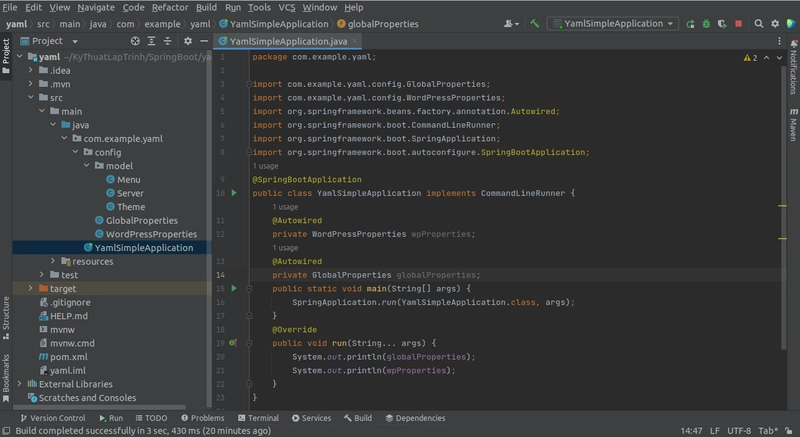In short, create a application.yml in the src/resources folder, Spring Boot will load and parse .yml file automatically and bind the values into the classes which annotated with @ConfigurationProperties. @ConfigurationProperties annotation allows to access properties set in configuration files (application.properties or application.yml) automatically and powerfully.
YAML and Properties
- application.yml
logging: level: org.springframework: ERROR com.example: DEBUG spring: profiles: active: dev main: banner-mode: off email: haunt.hcm2015@gmail.com thread-pool: 10 wordpress: menus: - title: Home name: Home path: / - title: About name: About path: /about themes: default-folder: /wp-content/themes/toptech servers: - ip: 127.0.0.1 path: /dev1 - ip: 127.0.0.2 path: /dev2 - ip: 127.0.0.3 path: /dev3 - application.properties ```properties
Spring Boot
logging.level.org.springframework=ERROR
logging.level.com.mkyong=DEBUG
spring.profiles.active=dev
spring.main.banner-mode=off
Global
email=haunt.hcm2015@gmail.com
thread-pool=10
WordPress
wordpress.menus[0].title=Home
wordpress.menus[0].name=Home
wordpress.menus[0].path=/
wordpress.menus[1].title=About
wordpress.menus[1].name=About
wordpress.menus[1].path=/about
wordpress.themes.default-folder=/wp-content/themes/toptech
wordpress.servers[0].ip=127.0.0.1
wordpress.servers[0].path=/dev1
wordpress.servers[1].ip=127.0.0.2
wordpress.servers[1].path=/dev2
wordpress.servers[2].ip=127.0.0.3
wordpress.servers[2].path=/dev3
## Project Structure  ## Project Dependency Spring Boot uses **_SnakeYAML_** library to parse the YAML file, and the **_SnakeYAML_** library is provided by **_spring-boot-starter_** The library and dependencies are configured in the **_pom.xml_** file ```xml <?xml version="1.0" encoding="UTF-8"?> <project xmlns="http://maven.apache.org/POM/4.0.0" xmlns:xsi="http://www.w3.org/2001/XMLSchema-instance" xsi:schemaLocation="http://maven.apache.org/POM/4.0.0 http://maven.apache.org/xsd/maven-4.0.0.xsd"> <modelVersion>4.0.0</modelVersion> <artifactId>spring-boot-yaml-example</artifactId> <packaging>jar</packaging> <name>Spring Boot YAML Example</name> <url>https://www.mkyong.com</url> <version>1.0</version> <parent> <groupId>org.springframework.boot</groupId> <artifactId>spring-boot-starter-parent</artifactId> <version>2.1.2.RELEASE</version> </parent> <properties> <java.version>1.8</java.version> </properties> <dependencies> <dependency> <groupId>org.springframework.boot</groupId> <artifactId>spring-boot-starter</artifactId> </dependency> </dependencies> <build> <plugins> <plugin> <groupId>org.springframework.boot</groupId> <artifactId>spring-boot-maven-plugin</artifactId> </plugin> <plugin> <groupId>org.apache.maven.plugins</groupId> <artifactId>maven-surefire-plugin</artifactId> <version>2.22.0</version> </plugin> </plugins> </build> </project> Spring Boot + YAML
Spring Boot will load and parse the YAML file and bind the values in the following @ConfigurationProperties classes.
- Menu.java
package com.example.yaml.config.model; public class Menu { private String name; private String path; private String title; public String getName() { return name; } public void setName(String name) { this.name = name; } public String getPath() { return path; } public void setPath(String path) { this.path = path; } public String getTitle() { return title; } public void setTitle(String title) { this.title = title; } @Override public String toString() { return "Menu{" + "name='" + name + '\'' + ", path='" + path + '\'' + ", title='" + title + '\'' + '}'; } } - Server.java
package com.example.yaml.config.model; public class Server { private String ip; private String path; public String getIp() { return ip; } public void setIp(String ip) { this.ip = ip; } public String getPath() { return path; } public void setPath(String path) { this.path = path; } @Override public String toString() { return "Server{" + "ip='" + ip + '\'' + ", path='" + path + '\'' + '}'; } } - Theme.java
package com.example.yaml.config.model; public class Theme { private String defaultFolder; public String getDefaultFolder() { return defaultFolder; } public void setDefaultFolder(String defaultFolder) { this.defaultFolder = defaultFolder; } @Override public String toString() { return "Theme{" + "defaultFolder='" + defaultFolder + '\'' + '}'; } } - GlobalProperties.java
package com.example.yaml.config; import org.springframework.boot.context.properties.ConfigurationProperties; import org.springframework.stereotype.Component; @Component @ConfigurationProperties public class GlobalProperties { private int threadPool; private String email; public int getThreadPool() { return threadPool; } public void setThreadPool(int threadPool) { this.threadPool = threadPool; } public String getEmail() { return email; } public void setEmail(String email) { this.email = email; } @Override public String toString() { return "GlobalProperties{" + "threadPool=" + threadPool + ", email='" + email + '\'' + '}'; } } The setter (and getter) names must correspond to the property names in the application.properties (or application.yml)
- WordPressProperties.java
package com.example.yaml.config; import com.example.yaml.config.model.Menu; import com.example.yaml.config.model.Server; import com.example.yaml.config.model.Theme; import org.springframework.boot.context.properties.ConfigurationProperties; import org.springframework.stereotype.Component; import java.util.ArrayList; import java.util.List; @Component @ConfigurationProperties("wordpress") public class WordPressProperties { private List<Menu> menus = new ArrayList<>(); private Theme themes; private List<Server> servers = new ArrayList<>(); public List<Menu> getMenus() { return menus; } public void setMenus(List<Menu> menus) { this.menus = menus; } public Theme getThemes() { return themes; } public void setThemes(Theme themes) { this.themes = themes; } public List<Server> getServers() { return servers; } public void setServers(List<Server> servers) { this.servers = servers; } @Override public String toString() { return "WordpressProperties{" + "menus=" + menus + ", themes=" + themes + ", servers=" + servers + '}'; } } Spring will automatically look for properties placed inside application.properties or application.yml prefixed with wordpress and inject them into the corresponding properties in the WordPressProperties class.
Start a Spring Boot normally and print out the values.







Top comments (0)